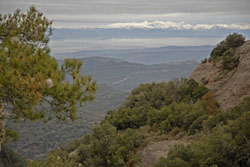Plant responses to global environmental change
Anthropogenic emissions of greenhouse gases are expected to raise the mean temperature of Earth's surface by 1.4 to 5.8 degrees Celsius during this century. Corresponding changes in air and soil temperatures, soil water and nutrient contents, as well as in concentrations of atmospheric carbon dioxide are likely to alter the way in which natural and managed ecosystems function. More specifically, predicted changes in climate may affect key soil processes such as respiration and nitrogen mineralisation, and thus key ecosystem functions, including carbon storage and nutrient availability. To identify the sensitivity of shrubland soil to these predicted changes, experimental manipulations at field scale were carried out by scientists of the Università degli Studi della Tuscia in Italy. These experimental manipulations involved ecosystem warming and prolonged summer drought in ericaceous shrublands across Europe. Warming was anticipated to affect the decomposition of organic matter in the soil. Increased turn over of the organic matter pool would be reflected in changes in the soil water composition; especially an increase in nitrogen content may be expected. Overall vegetation growth had increased in northern sites, which tend to be temperature-limited, primarily due to the increase in biomass of dominant shrub species. Continued monitoring enabled scientists to detect whether the increased plant production was a transitory effect, or a new equilibrium. It was concluded that the increased plant production was the result of both direct (climate) and indirect (nutrient availability) causes. Soil studies demonstrated an increase in the availability of nitrogen in both warming and drought treatments. On the other hand, carbon storage in the soil was found to be determined by the balance between carbon inputs (litter) and carbon lost through soil microbial activity and root respiration. The differences in important ecosystem processes among different sites could furthermore indicate the long-term consequences of climate changes. They may also serve as a powerful tool to evaluate the sensitivity of terrestrial ecosystems under different climatic conditions. More importantly, the VULCAN project research can support management practices to sustain the quality of these ecosystems in Europe.







